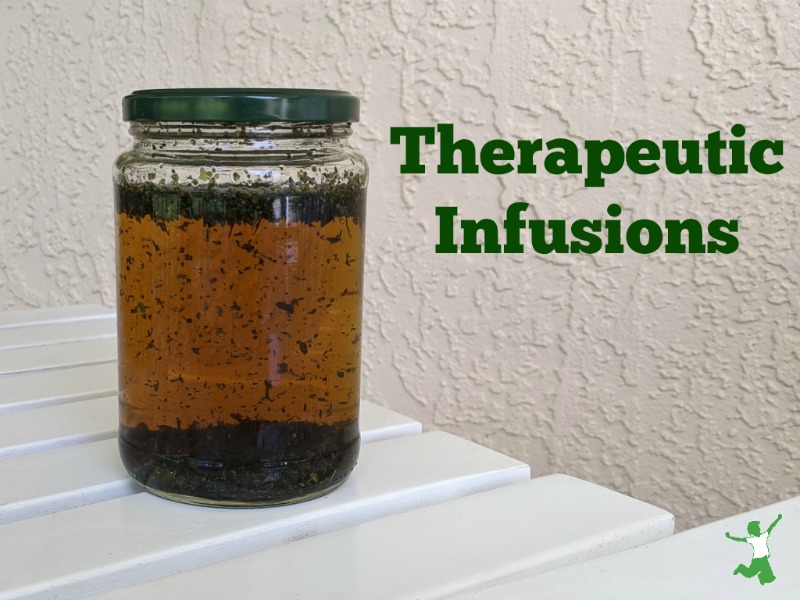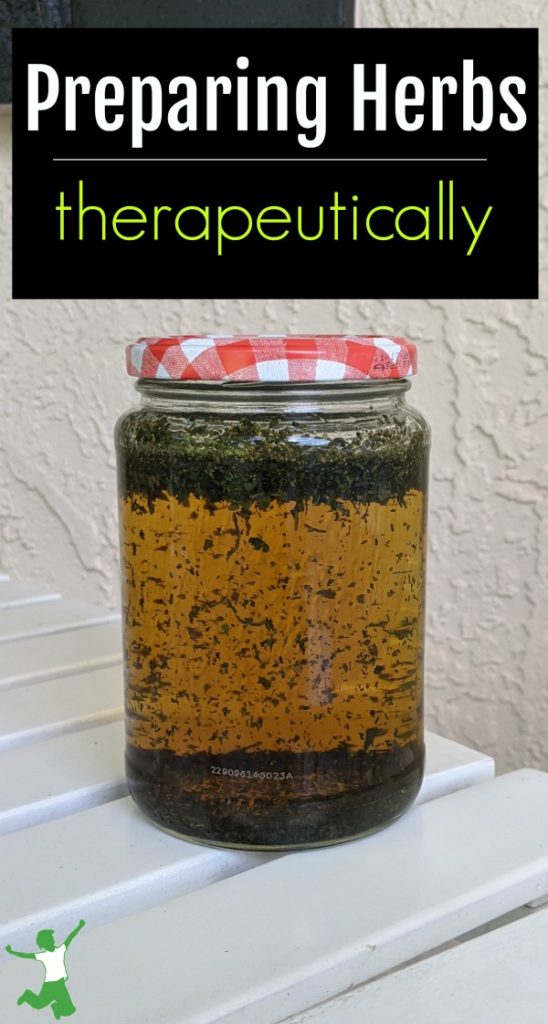Table of Contents[Hide][Show]
How to most effectively steep herbs into a potent and therapeutic infusion whether using tea, roots, bark, leaves, seeds, or flowers to experience the maximum health benefits with no side effects.
An infusion of fresh or dried herbs is typically used interchangeably with a simple cup of herbal tea.
The two are actually quite different both in taste and therapeutic benefits. A properly prepared infusion is more potent and easily absorbed than plain herbal tea. However, it is not as potent as a homemade herbal tincture.
If you plan to use herbs therapeutically as in the use of nettle tea during pregnancy to tone the uterus and prepare for natural childbirth, it is best to prepare herbal infusions instead of tea.
In fact, using tea bags can be a source of toxin exposure due to the manufacturing process. It is safest to use organic, loose tea or whole herbs to prepare traditional infusions if possible.
Herbal Infusion Benefits
The ease of assimilation and increased potency of herbal infusions is due to careful preparation. The process involves boiling water and steeping of the herbs for anywhere from 30 minutes to 8 hours depending on the type of plant matter used.
The boiling of the water releases any dissolved gases from the water into the air which are not reabsorbed by the water due to the tight-fitting lid on the steeping jar.
These dissolved gases can interfere with the rapid and complete assimilation of the nutrients released into the water by the herbs as they steep in the cooling water.
This boiling of water to release any dissolved gases and then cooling of the water in a glass jar with a tight lid to restrict the gases from redissolving back into the water is referred to as the “wonder water” effect. (1)
Using the wonder water principle, how should herbal infusions be properly prepared?
Very easily as it turns out.
Preparing Infusions
Note that the preparation of infusions varies slightly based on the part of the plant you intend to use. Below are guidelines on how much to use and how long to steep.
Roots and Bark
If making an herbal infusion using the roots or bark of a plant, use one ounce of plant matter per pint of water to be used.
Place the correct amount of plant matter at the bottom of a glass mason jar and fill to the top with boiling water. Screw the lid on tightly and leave at room temperature for 8 hours.
Leaves
Use one ounce of dried leaves per quart of water. Place the leaves in a quart mason jar and fill to the top with boiling water. Tightly screw on the lid and leave at room temperature for 4 hours.
Flowers and Seeds
One ounce of flowers per quart of water should be steeped in boiling water as it cools in a mason jar with a snugly fitting lid for no more than 2 hours.
Steep one ounce of seeds per pint of boiling water. Affix a tight-fitting lid on a mason jar and let sit for only 30 minutes.
Dosage and Storage
Before making your infusion, be sure your dried herbs are of proper potency. This article on storing bulk herbs and loose teas outlines how to preserve your precious plant matter!
Once the herbs have steeped for the proper amount of time, strain out the plant matter and drink 2 cups per day if you weigh between 125 – 150 lbs until the infusion is used up. (2)
Add an additional one-half cup per day for every 30-40 lbs additional weight. Similarly, if you weigh less than 125 lbs, reduce dosage by one-quarter cup for every 15-20 lbs.
Herbal infusions spoil rapidly so it is best to make and use them up as soon as possible.
Store unused portions in the refrigerator for no more than a day and then prepare a fresh batch. You also have the option of freezing them for later use. This article on freezing in plastic versus glass provides information on how to safely use either type of container.
Which Herbs to Try
Do you make and use herbal infusions on a regular basis? If so, which herbs do you use and for what purposes? Here are some ideas to get you started:
- How to use herbs for fertility
- Herbs for seasonal allergies
- Best herbal antibiotics
- Natural herbal birth control
- Best herbs for sounder sleep

(1) Wise Woman Herbal
(2) Natural Health and Herbal Medicine








Thank you for this. What SIZE mason jar, please???
It depends on how much and which type of plant matter you are using. For example, the section above “Roots and Bark” states that you should use one ounce of plant matter per pint of water to be used. So you can use a pint jar or a quart jar (if doubling the infusion size).
Gonna try this. It seems that this herbal has a lot of benefits to our health. Very helpful during these days.
Do you happen to think or know how to make infusions in the Instant Pot? I’m thinking it could cut down the wait time of steeping… Love to know your thoughts.
I would not recommend it. There is no research I can find on the effect of pressure on herbal potency.
If I make a strong infusion (i.e. several herbs at once), do I need to dilute it before drinking?
Wow! Great info on nettle here… I have a bunch growing wild in the woods behind my house — not to mention those in my yard! ;^D
Ariel, I have yet to find Nettle in the wild, although I have found Plantain and other herbs. Nettle appears to be so abundant and so many have found it, and I want to so bad! 🙂 Nettle has natural “stingers” hence the name Stinging Nettle, so if found fresh you must cook it first (or dry it and the dried has deactivated stingers as well). So just FYI – careful harvesting!
Nickole
Nettle is very safe and beneficial for pregnancy, as well as Alfalfa and Red Raspberry Leaf. We use those three herbs mixed with Peppermint to make a strong infusion. Great for digestion, bloating, nourishing the milk, etc.
We also use nettle in foods, such as soups and speghetti. It’s great to add for nutrition. 😉
Nickole
Hi Nickole,
How about Red Clover Blossoms during pregnancy? I’m using them toghether with Red Raspberry Leaf. And also what herbs would you recomend during nursing, for better milk?
Thank you
Olga, Red Clover is actually one of the herbs NOT recommended during pregnancy. There are herbs that are fantastic for milk supply!
A great Mother’s Milk blend would be:
Fenugreek
Blessed Thistle
Fennel Seed
Nettle Leaf
Alfalfa Leaf
Red Raspberry Leaf
(And now you have me thinking of creating a blend for this purpose 😉
I hope this helps!
Nickole
Thank you, Nickole!
Yes, already mixed blend is great idea. When I was breastfeeding my first child I was bying “Lactation tea” blend at the local herb store. I don’t really know what was in it, but I loved it, and they also had a small print out with steeping instructions, which was really helpfull.
Adrienne, you can buy Nettle at Mountain Rose Herbs or Pacific Botanicals. They both have very high quality products.
Sarah, I’m drinking my red clover leaf, red clover blossum, milky oats tops and blue violet leaf infusion as I write here. Delicious. I prepare and drink a quart of a variety of herbs almost every day and my health has never been better. I like to add a little stevia for sweetening and also hibiscus blossums to create a beautiful red beverage!!
Researchers have discovered anti-tumor properties in Red clover and it is high in antioxidants (Vit E) along with other nutrients: Vit B complex, calcium, chromium, magnesium, manganese, niacin, phosphorus and protein. It is useful as a tonic for menopause and for fertility as well (hopefully not “successful” for fertility for the menopausal woman, hehehehe…….). Also recommended for constipation, flushing toxins from the body and treating irritating coughs and pertussis. The blossums are particularly delightful to eat.
Milky Oats is a nervine herb – it soothes and calms-also contains silica for hair and nails.
I could go on and on but I won’t! I’ll just have another cup ‘ o’ clover!!!!!!
Where can you buy nettle?
Great article! I was going to recommend Susan’s website and there it was her name at the end of your article. Nettle is an excellent tonic for women – as most of you know!